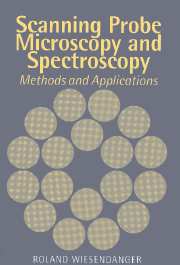Book contents
- Frontmatter
- Contents
- Preface
- List of acronyms
- Introduction
- Part one Experimental methods and theoretical background of scanning probe microscopy and spectroscopy
- Part two Applications of scanning probe microscopy and spectroscopy
- 4 Condensed matter physics
- 5 Chemistry
- 6 Organic material
- 7 Metrology and standards
- 8 Nanotechnology
- References
- Index
6 - Organic material
Published online by Cambridge University Press: 05 October 2010
- Frontmatter
- Contents
- Preface
- List of acronyms
- Introduction
- Part one Experimental methods and theoretical background of scanning probe microscopy and spectroscopy
- Part two Applications of scanning probe microscopy and spectroscopy
- 4 Condensed matter physics
- 5 Chemistry
- 6 Organic material
- 7 Metrology and standards
- 8 Nanotechnology
- References
- Index
Summary
The application of scanning probe microscopy (SPM) to organic material, from small molecules to supramolecular assemblies, is a challenging task, which requires to address the following key issues.
Suitable substrates have to be found exhibiting a surface roughness considerably less than the size of the molecular species to be deposited in order to allow clear distinction between substrate and molecular features in SPM images. For SPM studies under ambient conditions, substrate surfaces must be chemically inert. The applicability of STM additionally requires electrically conducting substrates.
Deposited molecular species have to be immobilized in some way to allow stable SPM imaging.
Interpretation of STM images of molecular species requires profound understanding of their electronic structure and transport properties. In addition, the elastic properties must be known for interpretation of STM as well as AFM results.
A variety of different substrates has already been tried for SPM studies of molecules and biological specimens. At first sight, layered materials (section 4.1.3) seem to be particularly attractive because they usually provide large, atomically flat terraces after sample cleavage. In addition, the surfaces of graphite or transition metal dichalcogenides (TMD), for instance, are relatively inert, which is favorable for SPM studies in ambient air. On the other hand, the binding strength of molecules to these surfaces tends to be low in the absence of surface defects.
- Type
- Chapter
- Information
- Scanning Probe Microscopy and SpectroscopyMethods and Applications, pp. 493 - 536Publisher: Cambridge University PressPrint publication year: 1994
- 1
- Cited by



